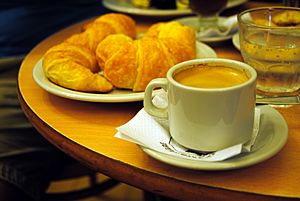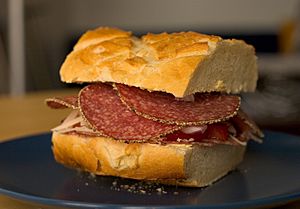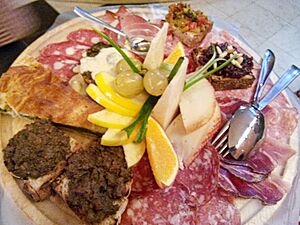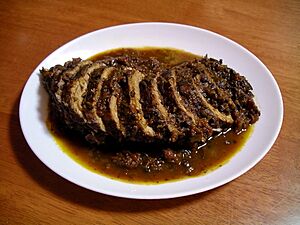Italian meal structure facts for kids
Have you ever wondered how people eat in different countries? In Italy, meals are a big part of life, especially for spending time with family and friends! The way Italians eat is a bit different from other parts of Europe. They usually have breakfast (colazione), lunch (pranzo), and supper (cena).
Italians don't focus much on breakfast. It's often light or even skipped. But they do enjoy snacks called merenda in the late morning or afternoon. Traditional Italian meals used to have four or five courses. This is because meals are seen as a time to connect, not just to eat. During holidays like Christmas, these big meals can last for many hours!
Today, full-course meals are mostly for special events like weddings. For everyday meals, Italians might have just a first or second course, a side dish, and coffee. The primo (first course) is often a filling dish like risotto or pasta. It comes with sauces made from meat, vegetables, or seafood. The secondo (second course) usually has meat, like sausages or chicken. Sometimes, Italians have a piatto unico (single dish) that combines starches and proteins.
Contents
Meals Through the Day
Breakfast: Colazione
Most Italians enjoy a sweet breakfast. They might eat it at home or at a café. At home, they often have coffee (like espresso or coffee made with a moka pot), milk, or latte. This is usually with baked goods like biscuits. They might also have slices of bread with butter and jam, honey, or chocolate-hazelnut cream called gianduja. Sometimes, they drink fruit juice instead of milk. On special days, like Sundays, they might have cakes, pies, or other local treats.
If they go to a café, espresso is very popular. They also like cappuccino or latte macchiato. These are often served with a cornetto (a type of croissant), bombolone (a filled donut), or other pastries. There are many different breakfast sweets, and some are only found in certain regions. In recent years, other coffee drinks like mocaccino and marocchino have also become popular.
A savory breakfast is less common but still happens. It's usually lighter than savory breakfasts in other European countries. It might be focaccia (a flatbread) or toasted homemade bread. This bread is often seasoned with olive oil, tomato, or sliced salami. Many Italians simply drink coffee for breakfast without any food.
Lunch: Pranzo
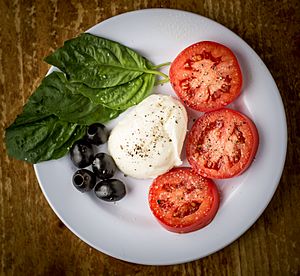
In Italy, lunch (Pranzo) is often seen as the most important meal. A full lunch usually has four courses:
- A first course (Primo): This is often pasta, risotto, rice, polenta, legumes, or a soup.
- A second course (Secondo): This includes meat, fish, dairy products like cheese, or eggs. Eggs can be served in many ways, like in a frittata (an omelet).
- A side dish: This is raw or cooked vegetables that go with the second course.
- Seasonal fruit: This is eaten at the end.
Bread always comes with the second course and side dish. After lunch, it's traditional to have a cup of espresso. This might be followed by an ammazzacaffè. This is a small glass of local liqueur, which can be bitter or sweet.
For special events, like holidays, two more courses are added:
- An appetizer: This is eaten before the meal to get your appetite ready. It's usually a small portion. It can be cold or hot. Examples include crostini, bruschetta, salami, cheeses, vegetables, or seafood dishes.
- A dessert: This is eaten at the very end.
Wine is often served with lunch and dinner.
Snack Time: Merenda
The merenda is not a main meal. It's an important snack that happens in the mid-morning (around 10 AM) or mid-afternoon (around 5 PM). It's usually a light meal. It could be a panino (sandwich) or tramezzino (a triangular sandwich). It might also be just fruit, or bread with jam. In summer, some people have ice cream. Kids often have merenda, but it's also common for adults.
Supper: Cena
Supper (Cena) is the other main meal of the day, along with lunch. The structure of supper is similar to lunch. However, the dishes and foods are usually lighter.
There are exceptions, though! Suppers called cenoni are eaten on special holidays. These include New Year's Eve, Christmas Eve, and during the Carnival period. These dinners are much richer and bigger than regular lunches.
When close family members eat supper together, they don't always have a first course with starchy foods like pasta or cereals like rice. Sometimes, supper is just like a second course from lunch. This means it might be a meat or fish dish, with or without a side dish. Or it could be a single dish like a soup. Bread is almost always included.
Special Occasion Meals
When Italians have a big celebration, like a holiday, they follow a more formal meal structure. It's a true feast!
- Aperitivo
- This is how a special meal begins. It's like a pre-dinner drink. People often stand around and enjoy drinks like wine, prosecco, or gingerino. Small snacks might be served too, such as olives, chips, nuts, or cheese.
- Antipasto
- The antipasto is a starter that's a bit more filling than the aperitivo snacks. It's usually cold and lighter than the first course. Examples include salumi (cured meats like salame or prosciutto), cheeses, or small sandwiches like bruschetta. Marinated vegetables or seafood might also be served.
- Primo
- The primo is the first main course. It's a hot dish and is usually more substantial than the antipasto. It's lighter than the second course. Dishes without meat are common here. Think risotto, pasta with seafood or vegetable sauces, soup, gnocchi, or lasagne.
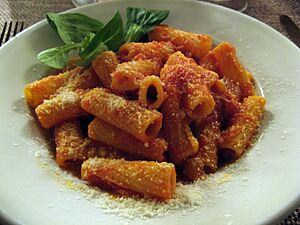
- Secondo
- This course features different kinds of meat or fish. You might find turkey, sausage, pork, steak, beef, salmon, or chicken. Depending on the region, either the primo or the secondo might be considered the most important part of the meal.
- Contorno
- A contorno is a side dish. It's usually served with the secondo piatto. These are often vegetables, either raw or cooked, hot or cold. They are typically served on a separate plate, not on the same plate as the meat.
- Insalata
- If the contorno already had a lot of leafy greens, a separate salad might not be served. Otherwise, a fresh garden salad could be brought out at this point.
- Formaggi e frutta
- This course is dedicated to local cheeses and fresh seasonal fruit. The cheeses will be ones that are typical of the region.
- Dolce
- Next comes the dolce, or dessert. Popular choices include tiramisu, panna cotta, cake, or pie. During Christmas, panettone or pandoro are common. For Easter, there's Colomba Pasquale. You might also have gelato (ice cream) or sorbetto (sorbet). While some desserts are popular everywhere, many regions have their own special treats. For example, cassata and cannoli are famous in Sicily.
- Caffè
- Coffee is often drunk at the end of a meal, even after the digestivo. Italians usually don't drink milky coffees like cappuccino after meals. Instead, they prefer strong coffee like espresso. It's often drunk quickly from small cups while still hot.
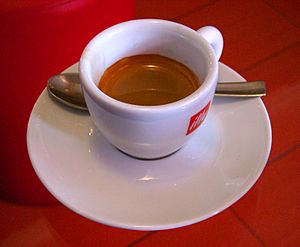
- Digestivo
- The digestivo is the drink that finishes the meal. It's also called ammazzacaffè if it's served after the coffee. Drinks like grappa, amaro, or limoncello are popular. The name digestivo means these drinks are thought to help you digest a long meal.


